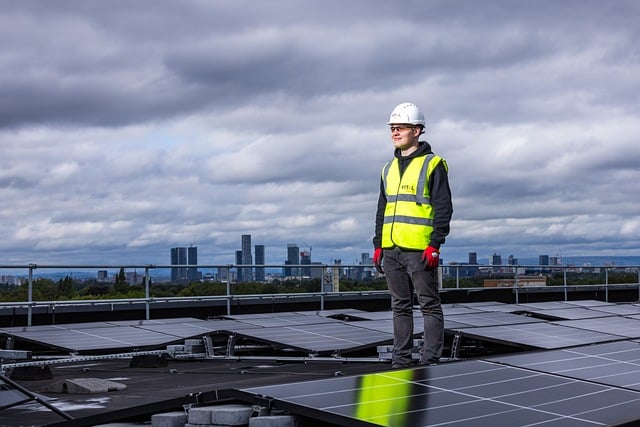“Empowering Solar Efficiency: IoT-Driven Insights for Optimal Performance Monitoring.”
The Internet of Things (IoT) plays a pivotal role in enhancing solar performance monitoring by enabling real-time data collection, analysis, and management of solar energy systems. Through the integration of smart sensors and connected devices, IoT facilitates continuous monitoring of solar panel efficiency, energy output, and environmental conditions. This technology allows for proactive maintenance, performance optimization, and data-driven decision-making, ultimately leading to increased energy production and reduced operational costs. By leveraging IoT solutions, stakeholders can gain valuable insights into system performance, identify potential issues early, and ensure the long-term sustainability of solar energy investments.
Enhanced Data Collection Through IoT Devices
The integration of Internet of Things (IoT) technology into solar performance monitoring has revolutionized the way data is collected and analyzed, leading to significant improvements in efficiency and reliability. At the heart of this transformation is the ability of IoT devices to gather real-time data from solar panels, inverters, and other components of solar energy systems. This enhanced data collection not only provides insights into the operational status of solar installations but also facilitates proactive maintenance and optimization strategies.
One of the primary advantages of IoT devices in solar performance monitoring is their capacity to collect vast amounts of data continuously. Traditional monitoring systems often relied on periodic manual checks or limited data sampling, which could lead to gaps in information and delayed responses to performance issues. In contrast, IoT-enabled sensors can monitor various parameters, such as energy output, temperature, and environmental conditions, at frequent intervals. This continuous stream of data allows for a more comprehensive understanding of how solar systems are performing under different conditions, ultimately leading to better decision-making.
Moreover, the data collected by IoT devices can be transmitted in real-time to centralized platforms for analysis. This capability enables operators to visualize performance metrics through user-friendly dashboards, making it easier to identify trends and anomalies. For instance, if a particular solar panel is underperforming, the system can quickly alert operators, allowing them to investigate and address the issue before it escalates into a more significant problem. This proactive approach not only enhances the longevity of solar installations but also maximizes energy production, ensuring that systems operate at their optimal capacity.
In addition to real-time monitoring, IoT devices facilitate the integration of advanced analytics and machine learning algorithms. By leveraging historical data alongside real-time inputs, these technologies can predict potential failures and recommend maintenance schedules tailored to the specific needs of each solar installation. This predictive maintenance approach is a game-changer, as it shifts the focus from reactive repairs to strategic planning, ultimately reducing downtime and maintenance costs.
Furthermore, the enhanced data collection capabilities of IoT devices contribute to improved energy management. With detailed insights into energy production and consumption patterns, operators can make informed decisions about energy storage and distribution. For example, if data indicates that energy production is peaking during certain hours, operators can optimize battery storage systems to capture excess energy for use during periods of low production. This level of granularity in data analysis empowers solar operators to maximize their return on investment while contributing to a more stable and resilient energy grid.
The role of IoT in solar performance monitoring extends beyond individual installations; it also has implications for broader energy management strategies. Aggregated data from multiple solar systems can provide valuable insights into regional energy trends, helping utilities and policymakers make informed decisions about energy distribution and infrastructure development. By harnessing the power of IoT, stakeholders can better understand the dynamics of solar energy generation and its impact on the overall energy landscape.
In conclusion, the enhanced data collection capabilities afforded by IoT devices are transforming solar performance monitoring into a more efficient, proactive, and data-driven process. By enabling real-time monitoring, predictive maintenance, and advanced analytics, IoT technology not only optimizes the performance of solar installations but also contributes to the broader goals of energy management and sustainability. As the adoption of IoT in the solar industry continues to grow, it promises to unlock new levels of efficiency and reliability, paving the way for a cleaner and more sustainable energy future.
Real-Time Performance Analytics for Solar Systems

The integration of the Internet of Things (IoT) into solar performance monitoring has revolutionized the way we assess and optimize solar energy systems. By leveraging real-time performance analytics, stakeholders can gain unprecedented insights into the operational efficiency of solar installations. This capability is particularly crucial as the demand for renewable energy sources continues to rise, necessitating effective monitoring solutions to ensure optimal performance and return on investment.
At the heart of IoT-enabled solar performance monitoring is the ability to collect and analyze data from various components of a solar system. Sensors installed on solar panels, inverters, and other critical equipment continuously gather information regarding energy production, environmental conditions, and system health. This data is then transmitted to cloud-based platforms, where advanced analytics tools process it in real time. Consequently, operators can monitor performance metrics such as energy output, efficiency ratios, and potential system failures instantaneously.
One of the most significant advantages of real-time performance analytics is the early detection of anomalies. For instance, if a solar panel is underperforming due to shading, dirt accumulation, or equipment malfunction, IoT systems can alert operators immediately. This proactive approach allows for timely interventions, minimizing downtime and ensuring that energy production remains at optimal levels. Moreover, by identifying trends and patterns in performance data, operators can implement predictive maintenance strategies, addressing issues before they escalate into costly repairs or system failures.
Furthermore, real-time analytics facilitate enhanced decision-making for solar system operators. By having access to comprehensive performance data, stakeholders can make informed choices regarding system upgrades, operational adjustments, and energy management strategies. For example, if analytics reveal that certain panels consistently underperform, operators may decide to replace them or adjust their positioning to maximize sunlight exposure. This data-driven approach not only improves the efficiency of existing systems but also informs future installations, leading to better design and implementation practices.
In addition to operational benefits, real-time performance analytics also play a crucial role in financial management. Investors and stakeholders can track the financial performance of solar systems through metrics such as return on investment (ROI) and payback periods. By correlating energy production data with financial outcomes, operators can better understand the economic viability of their solar investments. This transparency is particularly important in attracting new investors and securing funding for future projects, as it demonstrates a commitment to maximizing efficiency and profitability.
Moreover, the integration of IoT in solar performance monitoring enhances the overall user experience for end-users. Homeowners and businesses can access real-time data through user-friendly dashboards, allowing them to monitor their energy production and consumption patterns. This level of engagement not only fosters a greater understanding of energy usage but also encourages energy conservation practices. As users become more aware of their energy consumption, they are more likely to adopt behaviors that contribute to sustainability, further amplifying the positive impact of solar energy.
In conclusion, the role of IoT in solar performance monitoring through real-time performance analytics is transformative. By enabling continuous data collection and analysis, IoT technology empowers operators to optimize system performance, enhance decision-making, and improve financial outcomes. As the solar industry continues to evolve, the integration of IoT will undoubtedly play a pivotal role in driving efficiency, sustainability, and innovation in solar energy systems. The future of solar energy is not only bright but also smart, thanks to the advancements in IoT technology.
Predictive Maintenance Using IoT Sensors
The integration of Internet of Things (IoT) technology into solar performance monitoring has revolutionized the way we approach predictive maintenance in solar energy systems. By leveraging IoT sensors, operators can gain real-time insights into the operational status of solar panels, inverters, and other critical components. This capability not only enhances the efficiency of solar energy production but also significantly reduces downtime and maintenance costs.
To begin with, IoT sensors are strategically placed throughout solar installations to continuously collect data on various performance metrics. These metrics can include temperature, voltage, current, and even environmental conditions such as sunlight intensity and weather patterns. By analyzing this data, operators can identify trends and anomalies that may indicate potential issues before they escalate into significant problems. For instance, if a sensor detects a drop in voltage from a particular solar panel, it may signal that the panel is underperforming due to dirt accumulation or a malfunction. This early detection allows for timely intervention, ensuring that the system operates at optimal efficiency.
Moreover, the predictive maintenance capabilities of IoT extend beyond mere data collection. Advanced analytics and machine learning algorithms can be applied to the data gathered by these sensors, enabling operators to predict when maintenance is required. This predictive approach contrasts sharply with traditional maintenance strategies, which often rely on scheduled inspections or reactive measures after a failure occurs. By utilizing IoT technology, solar operators can transition to a more proactive maintenance model, thereby minimizing unexpected outages and extending the lifespan of their equipment.
In addition to improving operational efficiency, predictive maintenance powered by IoT sensors can lead to significant cost savings. By addressing issues before they result in equipment failure, operators can avoid costly repairs and replacements. Furthermore, the ability to optimize maintenance schedules based on actual performance data means that resources can be allocated more effectively. For example, if a particular inverter consistently shows signs of wear, maintenance can be scheduled specifically for that unit, rather than conducting blanket inspections across the entire system. This targeted approach not only saves time but also reduces labor costs associated with unnecessary maintenance activities.
Another critical aspect of IoT in predictive maintenance is the enhancement of safety protocols. Solar installations can be hazardous environments, particularly when dealing with high-voltage equipment. By utilizing IoT sensors to monitor equipment health, operators can ensure that maintenance personnel are only dispatched when necessary and that they are fully informed about the condition of the equipment they are working on. This not only protects the workers but also enhances the overall safety of the installation.
Furthermore, the data collected through IoT sensors can be invaluable for long-term strategic planning. By analyzing historical performance data, operators can identify patterns and make informed decisions about future investments in technology or infrastructure. This data-driven approach allows for more accurate forecasting of energy production and better alignment with market demands.
In conclusion, the role of IoT in solar performance monitoring, particularly in the realm of predictive maintenance, cannot be overstated. By harnessing the power of real-time data collection and advanced analytics, solar operators can enhance efficiency, reduce costs, and improve safety. As the solar industry continues to evolve, the integration of IoT technology will undoubtedly play a pivotal role in shaping the future of renewable energy management.
Integration of IoT with Solar Energy Management Systems
The integration of the Internet of Things (IoT) with solar energy management systems represents a significant advancement in the way solar energy is monitored and optimized. As the demand for renewable energy sources continues to rise, the need for efficient management of solar power systems has become increasingly critical. IoT technology facilitates real-time data collection and analysis, enabling solar energy providers to enhance performance, reduce costs, and improve overall system reliability.
At the core of this integration is the ability of IoT devices to gather vast amounts of data from solar panels, inverters, and other components of solar energy systems. These devices, equipped with sensors, can monitor various parameters such as energy production, temperature, and environmental conditions. By transmitting this data to centralized management platforms, operators can gain insights into the performance of their solar installations. This real-time monitoring allows for immediate identification of issues, such as shading or equipment malfunctions, which can significantly impact energy output.
Moreover, the integration of IoT with solar energy management systems enables predictive maintenance. By analyzing historical data and current performance metrics, machine learning algorithms can predict when a component is likely to fail or underperform. This proactive approach not only minimizes downtime but also extends the lifespan of solar equipment, ultimately leading to cost savings for operators. Consequently, the ability to anticipate maintenance needs transforms the operational strategy from reactive to proactive, enhancing the overall efficiency of solar energy systems.
In addition to improving maintenance practices, IoT integration facilitates better energy management. With the data collected from various sensors, solar energy providers can optimize energy production and consumption patterns. For instance, smart algorithms can analyze energy usage trends and adjust the operation of solar panels accordingly, ensuring that energy is produced when it is most needed. This capability is particularly beneficial in regions with variable weather conditions, where solar output can fluctuate significantly. By aligning energy production with demand, operators can maximize the utilization of generated solar power, reducing reliance on grid electricity and lowering energy costs.
Furthermore, the integration of IoT with solar energy management systems enhances the ability to engage with consumers. Through mobile applications and web platforms, users can access real-time data about their energy consumption and production. This transparency empowers consumers to make informed decisions about their energy usage, encouraging energy conservation and promoting a more sustainable lifestyle. Additionally, by providing users with insights into their solar system’s performance, operators can foster a sense of ownership and satisfaction, ultimately leading to increased customer loyalty.
As the solar industry continues to evolve, the role of IoT in solar performance monitoring will only become more pronounced. The ongoing advancements in IoT technology, such as improved connectivity and data analytics capabilities, will further enhance the integration with solar energy management systems. This evolution will not only lead to more efficient solar operations but also contribute to the broader goal of achieving a sustainable energy future. In conclusion, the integration of IoT with solar energy management systems is a transformative development that enhances performance monitoring, predictive maintenance, energy management, and consumer engagement. As these technologies continue to advance, they will play a crucial role in optimizing solar energy systems and driving the transition towards renewable energy sources.
Q&A
1. **Question:** How does IoT enhance solar performance monitoring?
**Answer:** IoT enhances solar performance monitoring by providing real-time data collection and analysis from solar panels, enabling operators to track energy production, detect faults, and optimize performance remotely.
2. **Question:** What types of data can IoT devices collect for solar monitoring?
**Answer:** IoT devices can collect data on energy output, temperature, humidity, solar irradiance, and system health metrics, allowing for comprehensive performance assessments.
3. **Question:** How does IoT contribute to predictive maintenance in solar systems?
**Answer:** IoT contributes to predictive maintenance by using data analytics to identify patterns and anomalies, allowing for proactive repairs and reducing downtime through timely interventions.
4. **Question:** What are the benefits of using IoT for solar performance monitoring?
**Answer:** The benefits include improved efficiency, reduced operational costs, enhanced system reliability, and the ability to make data-driven decisions for better energy management.
Conclusion
The Internet of Things (IoT) plays a crucial role in solar performance monitoring by enabling real-time data collection, analysis, and management of solar energy systems. Through the integration of smart sensors and connected devices, IoT facilitates continuous monitoring of solar panel efficiency, energy output, and environmental conditions. This data-driven approach allows for proactive maintenance, optimization of energy production, and enhanced decision-making for system operators. Ultimately, IoT enhances the reliability and efficiency of solar energy systems, contributing to the overall effectiveness of renewable energy solutions.




